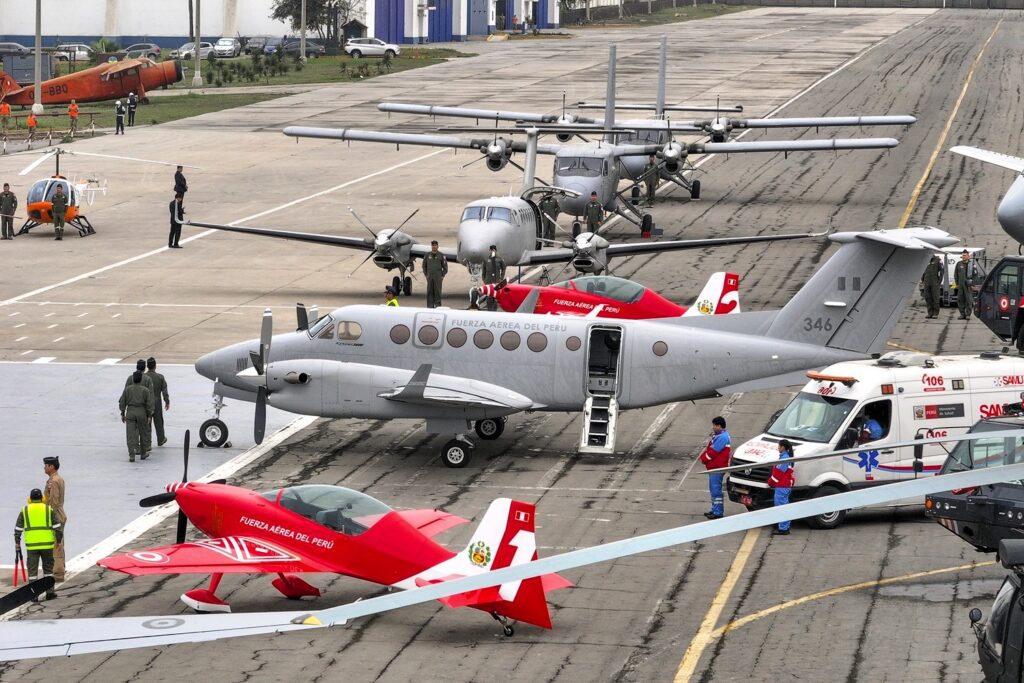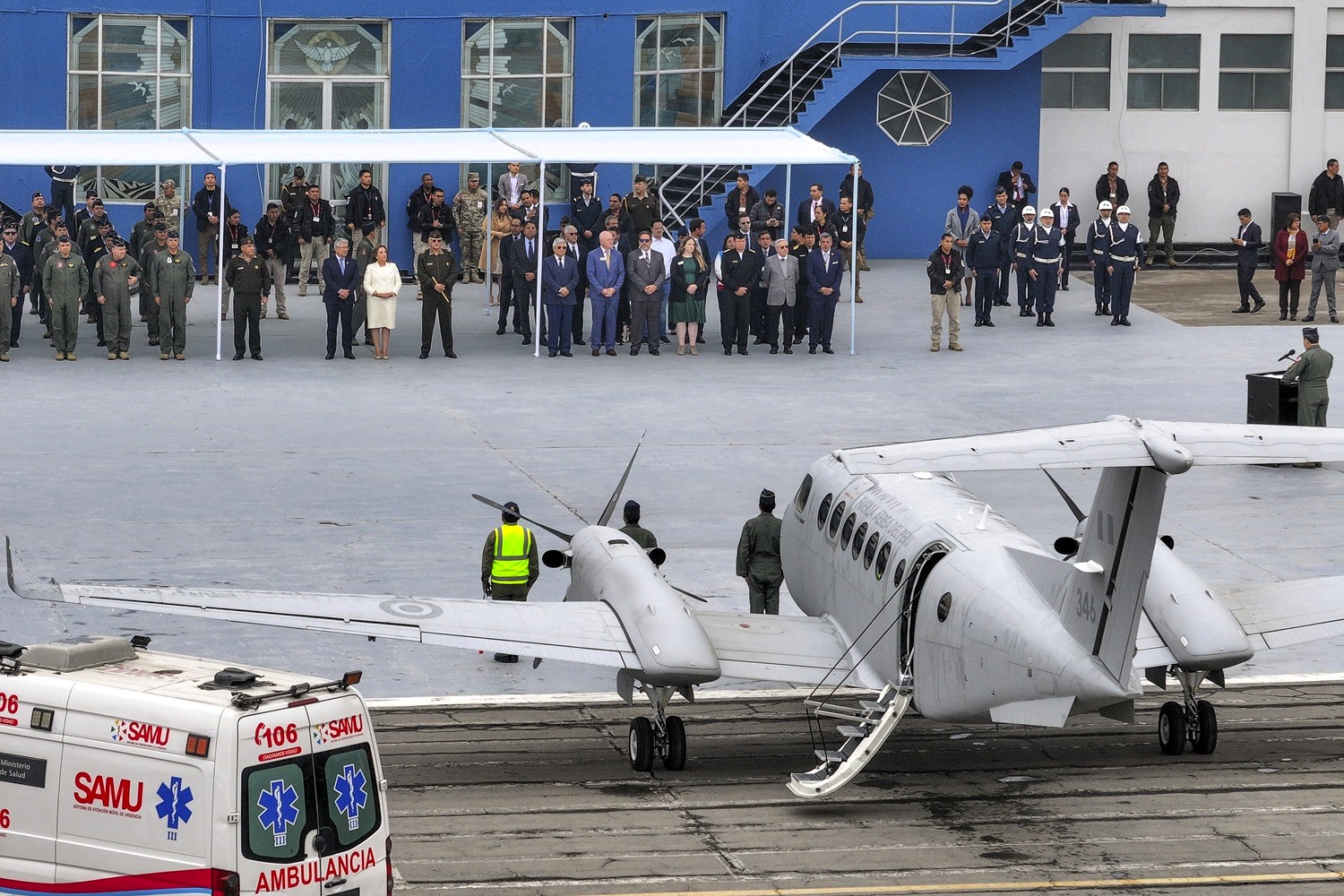Agencia Peruana de Noticias PRENSAPERU.PE https://prensaperu.pe/ Twitter: @prensaperupe La Presidenta de la República, Dina Ercilia Boluarte Zegarra, reafirmó el compromiso del Gobierno Peruano de garantizar la preparación y capacidad de respuesta de las Fuerzas Armadas (FF.AA.) ante emergencias nacionales; este anuncio se realizó durante la presentación de nuevas aeronaves y la modernización de equipos existentes en la Fuerza Aérea del Perú (FAP). El objetivo principal es fortalecer la defensa nacional, la gestión de riesgos de desastres y el desarrollo socioeconómico del país.
1.- ADQUISICIÓN Y PRESENTACIÓN DE NUEVAS AERONAVES.
Aeronave Ambulancia Beechcraft King Air 360C.
Esta aeronave está equipada con tecnología médica avanzada, incluyendo monitores de signos vitales, camillas especializadas, incubadoras y sistemas de refrigeración para el transporte de órganos. Su función principal es proporcionar evacuación aeromédica y transporte de emergencia a nivel nacional.
Aeronaves de Instrucción Primaria Geimber GB1.
Asignadas al Grupo Aéreo N° 6 en Chiclayo, estas aeronaves están diseñadas para la formación de nuevos pilotos y el entrenamiento de la escuadrilla acrobática Bicolor.
Helicópteros Enstrom F280 FX.
Estos helicópteros son ideales para la instrucción de vuelo, el entrenamiento en maniobras básicas y la respuesta ante emergencias.
2.- PUESTA EN OPERATIVIDAD Y MODERNIZACIÓN DE AERONAVES EXISTENTES.
Reparación y Modernización.
Se han realizado trabajos de reparación y modernización en un grupo de aeronaves existentes para optimizar su operatividad y prolongar su vida útil. Esto asegura que la FAP cuente con una flota funcional y eficiente.
3.- IMPACTO EN LA ATENCIÓN MÉDICA Y EVACUACIÓN AEROMÉDICA.
Resultados Concretos.
Desde la entrega de la primera aeronave ambulancia en octubre de 2024, se han realizado más de 100 vuelos aeromédicos, evacuando a más de 145 personas en estado crítico, especialmente en zonas remotas y de difícil acceso. La segunda aeronave ambulancia fortalecerá aún más esta capacidad.
4.- VISIÓN ESTRATÉGICA DEL GOBIERNO.
Fortalecimiento Integral de las FF.AA.
La presidenta Boluarte subrayó la importancia de fortalecer, modernizar, equipar y dotar a las FF.AA. con los mayores adelantos tecnológicos. Esto refleja una visión estratégica para asegurar la defensa nacional y la capacidad de respuesta ante cualquier eventualidad.
Contribución al Desarrollo Nacional.
Se destacó el rol crucial de las FF.AA. en el desarrollo del Perú, no solo en términos de seguridad y defensa, sino también en la gestión de riesgos de desastres y el apoyo a comunidades vulnerables.
5.- CONTEXTO ECONÓMICO Y CRECIMIENTO DEL PAÍS.
Crecimiento Económico Sostenido.
La presidenta resaltó que la economía peruana creció un 3.3 % en la primera mitad del año, una de las tasas más altas de Latinoamérica. Este crecimiento se basa en el gasto de las familias peruanas, impulsado por una inflación baja y controlada.
Gasto Privado.
El gasto privado superó los 348 000 millones de soles en los primeros seis meses del año, con una expansión de más del 3 %. Esto indica una mejora en la capacidad adquisitiva de los peruanos y un clima económico favorable.
Impacto en los Hogares.
El crecimiento económico está llegando al bolsillo de los peruanos, traduciéndose en hogares que progresan y familias que construyen un futuro mejor.
CINCO PUNTOS NO CUMPLIDOS DEL TODO.
1.- Cobertura Total en Zonas Remotas.
Aunque se han realizado avances significativos en la evacuación aeromédica, aún existen desafíos para garantizar una cobertura total en todas las zonas remotas del país. La geografía accidentada y la falta de infraestructura adecuada dificultan el acceso a ciertas áreas.
2.- Sostenibilidad de la Inversión.
Es crucial asegurar la sostenibilidad de la inversión en equipamiento y modernización de las FF.AA. a largo plazo. Esto implica establecer mecanismos de financiamiento adecuados y garantizar el mantenimiento y la capacitación continua del personal.
3.- Coordinación Interinstitucional.
Si bien se destaca la importancia de la coordinación entre las FF.AA. y otras instituciones, es necesario fortalecer aún más esta colaboración para optimizar la respuesta ante emergencias y desastres. Esto incluye la creación de protocolos claros y la realización de ejercicios conjuntos.
4.- Evaluación del Impacto Socioeconómico.
Aunque se menciona el crecimiento económico del país, es importante realizar una evaluación más detallada del impacto socioeconómico de las inversiones en las FF.AA. Esto permitiría identificar áreas de mejora y maximizar los beneficios para la población.
6.- Transparencia y Rendición de Cuentas.
Es fundamental garantizar la transparencia y la rendición de cuentas en la gestión de los recursos destinados a las FF.AA. Esto incluye la publicación de información detallada sobre las adquisiciones y los proyectos de modernización, así como la implementación de mecanismos de control y supervisión.
CONCLUSIÓN
La adquisición de nuevas aeronaves y la modernización de equipos existentes en la FAP representan un avance significativo en el fortalecimiento de las Fuerzas Armadas del Perú. Estas acciones no solo mejoran la capacidad de respuesta ante emergencias y desastres naturales, sino que también contribuyen al desarrollo socioeconómico del país. El compromiso del gobierno con la modernización de las FF.AA. y el crecimiento económico sostenido sienta las bases para un futuro más seguro y próspero para todos los peruanos.
Fuente: Agencia Peruana de Noticias PRENSAPERU.PE https://prensaperu.pe/ Twitter: @prensaperupe

English Translation
Peruvian Armed Forces Deploy Wings of Steel: “It Strengthens National Defense and Rescue. What Changes for the Citizen?”
Peruvian News Agency PRENSAPERU.PE https://prensaperu.pe/ Twitter: @prensaperupe The President of the Republic, Dina Ercilia Boluarte Zegarra, reaffirmed the Peruvian Government’s commitment to ensuring the preparedness and response capacity of the Armed Forces (FF.AA.) in the face of national emergencies. This announcement was made during the presentation of new aircraft and the modernization of existing equipment at the Peruvian Air Force (FAP). The main objective is to strengthen national defense, disaster risk management, and the country’s socioeconomic development.
1.- ACQUISITION AND PRESENTATION OF NEW AIRCRAFT.
Beechcraft King Air 360C Ambulance Aircraft.
This aircraft is equipped with advanced medical technology, including vital signs monitors, specialized stretchers, incubators, and refrigeration systems for organ transport. Its primary function is to provide aeromedical evacuation and emergency transport nationwide.
Geimber GB1 Primary Training Aircraft.
Assigned to Air Group No. 6 in Chiclayo, these aircraft are designed for training new pilots and the Bicolor aerobatic squadron.
Enstrom F280 FX Helicopters.
These helicopters are ideal for flight training, basic maneuver training, and emergency response.
2.- COMMISSIONING AND MODERNIZATION OF EXISTING AIRCRAFT.
Repair and Modernization.
Repair and modernization work has been carried out on a group of existing aircraft to optimize their operational capacity and extend their useful life. This ensures that the FAP has a functional and efficient fleet.
3.- IMPACT ON MEDICAL CARE AND AEROMEDICAL EVACUATION.
Concrete Results.
Since the delivery of the first ambulance aircraft in October 2024, more than 100 aeromedical flights have been carried out, evacuating more than 145 people in critical condition, especially in remote and difficult-to-access areas. The second ambulance aircraft will further strengthen this capacity.
4.- STRATEGIC VISION OF THE GOVERNMENT.
Comprehensive Strengthening of the Armed Forces.
President Boluarte emphasized the importance of strengthening, modernizing, equipping, and providing the Armed Forces with the latest technological advances. This reflects a strategic vision to ensure national defense and the capacity to respond to any eventuality.
Contribution to National Development.
The crucial role of the Armed Forces in Peru’s development was highlighted, not only in terms of security and defense, but also in disaster risk management and support for vulnerable communities.
5.- ECONOMIC CONTEXT AND GROWTH OF THE COUNTRY.
Sustained Economic Growth.
The president highlighted that the Peruvian economy grew 3.3% in the first half of the year, one of the highest rates in Latin America. This growth is based on Peruvian household spending, driven by low and controlled inflation.
Private Spending.
Private spending exceeded 348 billion soles in the first six months of the year, an increase of more than 3%. This indicates an improvement in Peruvians’ purchasing power and a favorable economic climate.
Impact on Households.
Economic growth is reaching Peruvians’ pockets, translating into prosperous households and families building a better future.
FIVE POINTS NOT FULLY MET.
1.- Full Coverage in Remote Areas.
Although significant progress has been made in aeromedical evacuation, challenges remain in ensuring full coverage in all remote areas of the country. The rugged geography and lack of adequate infrastructure make access to certain areas difficult.
2.- Investment Sustainability.
It is crucial to ensure the long-term sustainability of investment in equipment and modernization of the Armed Forces. This involves establishing adequate financing mechanisms and ensuring the maintenance and ongoing training of personnel.
3.- Interinstitutional Coordination.
While the importance of coordination between the Armed Forces and other institutions is highlighted, it is necessary to further strengthen this collaboration to optimize the response to emergencies and disasters. This includes the creation of clear protocols and the conduct of joint exercises.
4.- Socioeconomic Impact Assessment.
Although the country’s economic growth is mentioned, it is important to conduct a more detailed assessment of the socioeconomic impact of investments in the Armed Forces. This would identify areas for improvement and maximize benefits for the population.
5.- Transparency and Accountability.
It is essential to ensure transparency and accountability in the management of resources allocated to the Armed Forces. This includes the publication of detailed information on procurement and modernization projects, as well as the implementation of control and oversight mechanisms.
CONCLUSIÓN
The acquisition of new aircraft and the modernization of existing equipment in the Peruvian Armed Forces (FAP) represent a significant step forward in strengthening the Peruvian Armed Forces. These actions not only improve the response capacity to emergencies and natural disasters but also contribute to the country’s socioeconomic development. The government’s commitment to the modernization of the Armed Forces and sustained economic growth lays the foundation for a more secure and prosperous future for all Peruvians.
Source: Peruvian News Agency PRENSAPERU.PE https://prensaperu.pe/ Twitter: @prensaperupe
